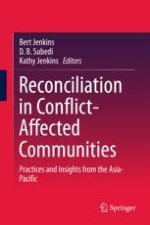2018 | OriginalPaper | Chapter
3. The Nexus Between Reintegration of Ex-combatants and Reconciliation in Nepal: A Social Capital Approach
Authors : D. B. Subedi, Bert Jenkins
Published in: Reconciliation in Conflict-Affected Communities
Publisher: Springer Singapore
Activate our intelligent search to find suitable subject content or patents.
Select sections of text to find matching patents with Artificial Intelligence. powered by
Select sections of text to find additional relevant content using AI-assisted search. powered by
